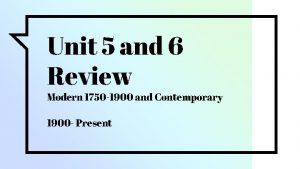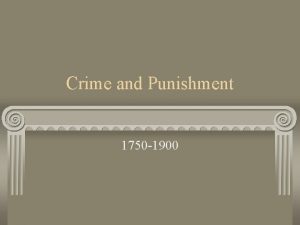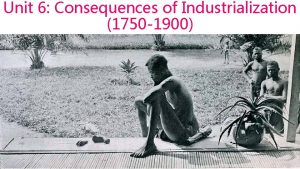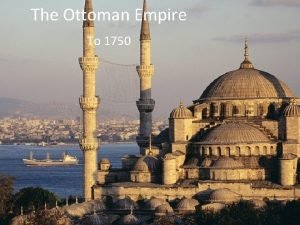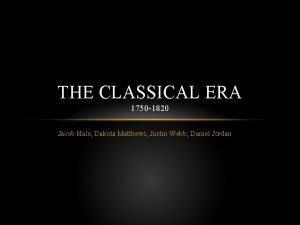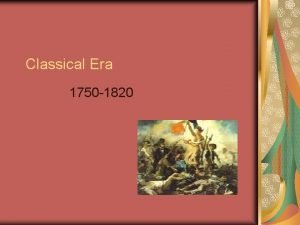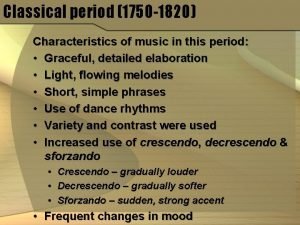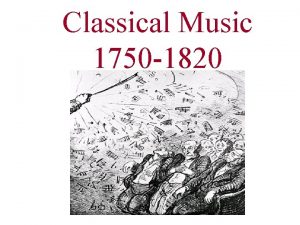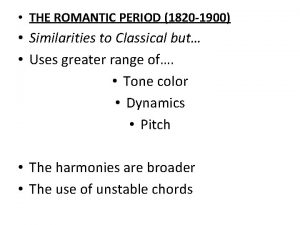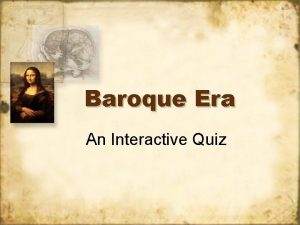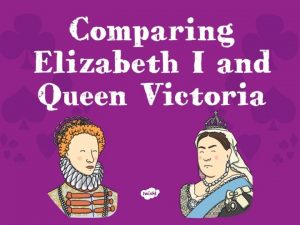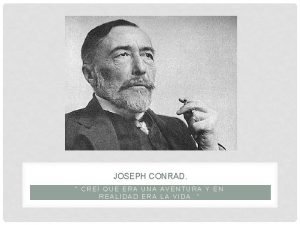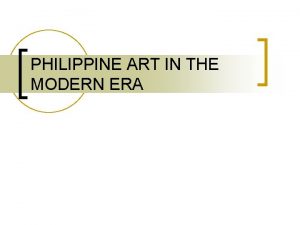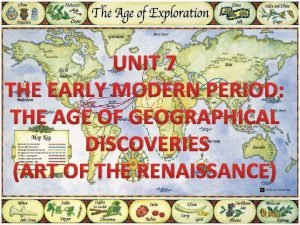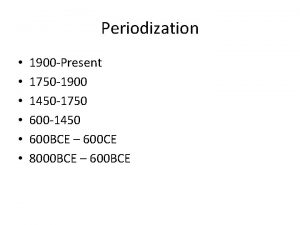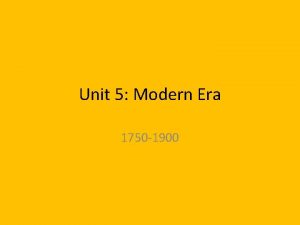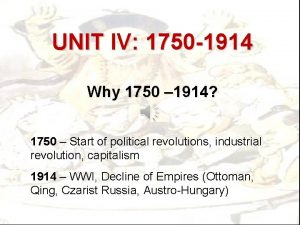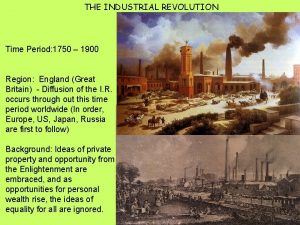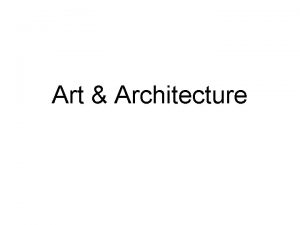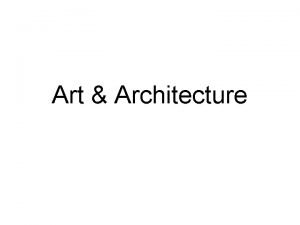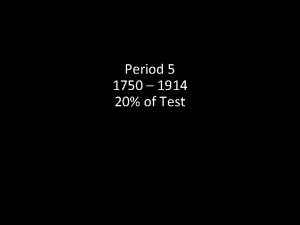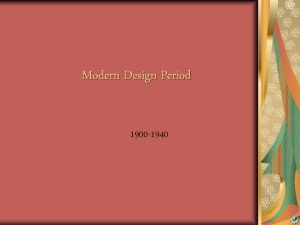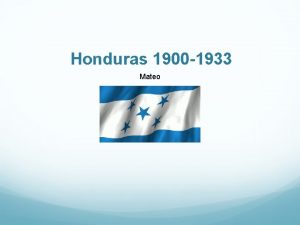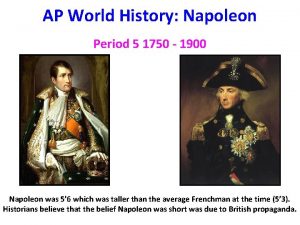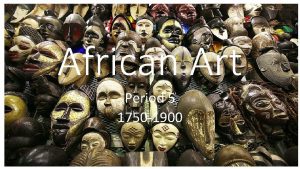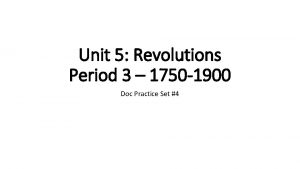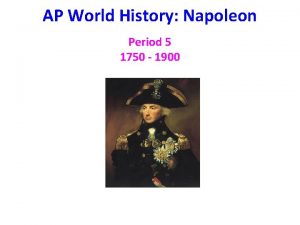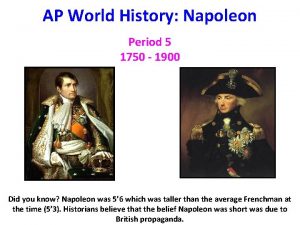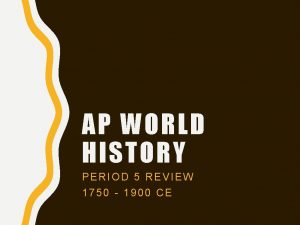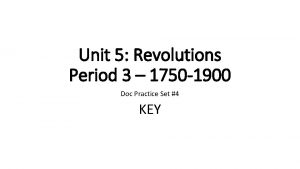Time Period 5 The Modern Era 1750 1900

































- Slides: 33

Time Period 5: The Modern Era 1750 -1900

1818: Zulu Kingdom founded 1848: Revolutions all around! 1848: Women’s Rights Convention in Seneca Falls, NY 1799 - 1815: Rule of Napoleon 1789 -1799: French Revolution 1898: Spanish. American War 50 18 50 17 1776: US Declaration of Independence 1754 -1763: French and Indian War 1868: Meiji Restoration 1861 -1865: US Civil War 1814 -1815: Congress of Vienna 00 1644 -1911: Qing Dynasty in China 1839 -1842: Opium War 00 1789: US Constitution ratified 18 1756 - 1763: Seven Years War 1869: Suez Canal Opens 1884: Berlin Conference 19 Time Period 5 Overview 1791: Slave revolt in Haiti 1803: Louisiana Purchase 1834: Abolition of Slavery in the British Empire 1867: End of Atlantic Slave Trade 1850 -1864: Taiping Rebellion 1853 -1856: Crimean War 1894: Sino. Japanese War

• The early modern era (1450 -1750) was dominated by European exploration • The modern era (1750 -1900) is dominated by how these Europeans handled their new found success • Economically- Industrial Revolution • Politically- Revolutions (French, American, Latin American, etc. ) • Four subsections in the modern era • • Industrial Revolution Imperialism Revolution Migration

Key Concept 5. 1: Industrialization and Global Capitalism • Industrialization fundamentally altered the production of goods around the world • How goods were produced and consumed • The idea of what a “good” is changed • Far-reaching effects on the global economy, social relations, and culture • The “Industrial Revolution was gradual and unfolded over the 18 th and 19 th centuries, eventually becoming global


1. Industrialization fundamentally changed how goods were produced • Development of machines, including steam engines, made it possible to exploit new resources of energy stored in fossil fuels, specifically coal and oil • The fossil fuels revolution greatly increased the energy available to human societies • Development of the factory system concentrated labor in a single location • Led to increasing degree of specialization of labor • New methods started in NW Europe, spread throughout Europe, United States, Russia, and Japan

2. New patterns of global trade and production developed and further integrated the global economy as industrialists sought raw materials and new markets for the increasing amount and variety of goods produced in their factories • Need for raw materials growth of export economies • Cotton, rubber, sugar, wheat, metals, etc. • Extensive mining centers • Encouraged industrialized states to seek out new consumer markets • British and French attempts to “open” China

3. To facilitate investments at all levels of industrial production, financiers developed and expanded various financial institutions • Capitalism and classical liberalism associated with Adam Smith and John Stuart Mill • Financial instruments (stock markets, insurance) expanded • Proliferation of large-scale transnational businesses 4. Major developments in transportation and communication • Railroads, steamships, telegraphs, canals

5. The development and spread of global capitalism led to a variety of responses • Many workers organized themselves to improve working conditions • Promotion of alternative visions (Utopian socialism, Marxism, Anarchism) • In a small number of states, governments promoted their own state-sponsored visions of industrialization • Meiji Japan • China’s Self-Strengthening Movement • To mitigate negative effects of industrial capitalism, some governments promoted various types of reforms • State pensions and public health in Germany • Expansion of suffrage in Britain • Public Education

6. The ways in which people organized themselves into societies also underwent significant transformations in industrialized states due to the fundamental restructuring of the global economy • New social classes developed o Middle class o Industrial working class • Family dynamics, gender roles changed • Rapid urbanization often led to unsanitary conditions


Key Concept 5. 2: Imperialism and Nation. State Formation • As states industrialized during this period, they also expanded their existing overseas colonies and established new types of colonies and transoceanic empires • Regional warfare and diplomacy • Process led mostly by Europe • Increase in European influence around the world • United States and Japan also participated • Growth of new empires challenged the power of existing land-based empires of Eurasia • New ideas about nationalism, race, gender, class, and culture • New national identities

1. Industrializing powers established transoceanic empires • States with existing colonies strengthened their control • European states, as well as the Americans and Japanese, established empires throughout Asia and the Pacific • Many European states used both warfare and diplomacy to establish empires in Africa • Spanish and Portuguese influence declined • In some parts of their empires, Europeans established settler colonies • Economic imperialism



2. Imperialism influenced state formation and contraction around the world • The expansion of U. S. and European influence over Tokugawa Japan led to the emergence of Meiji Japan • The United States and Russia expanded their land borders and conquered neighboring territories • Anti-imperial resistance led to the contraction of the Ottoman Empire • New states emerged on the edges of existing empires • Development and spread of nationalism 3. New racial ideologies, especially Social Darwinism, facilitated and justified imperialism

Detour: Absolutism Type of government in which a single monarch has supreme authority over his/her realm. They are not restricted by a Constitution and wields unrestricted power over its people

Absolute Monarchs You Need to Know Yes, technically they belong in Time Period 4 but they actually fit better in Time Period 5 • Henry VIII of England (r. 1509 - 1547) • King Louis XIV of France (r. 1643 - 1715) • Peter the Great of Russia (r. 1682 - 1725) • Catherine the Great of Russia (r. 1762 - 1796) • King Louis XVI of France (r. 1774 - 1792) We’ ll ta lk ab out him a noth er d ay

Henry VIII of England (r. 1509 - 1547) • Wanted to divorce his wife, Pope said no, Henry created the Church of England (aka Anglican Church) • Greatly expanded royal power • Divine Right

King Louis XIV of France (r. 1643 - 1715) • 11 th longest reign in history (72 years!) • Believed in Divine Right • Kings are chosen by God answer only to God • Centralized the government • Ended feudalism • Brought nobility to Versailles from the countryside • Absolute monarchy lasted until the French Revolution in 1790 Louis XIV is probably the best example of an absolute monarch

Versailles • Cost BILLIONS to build • But, that’s an estimate because Louis XIV destroyed all the accounting paperwork • Took over 50 years to build • 35, 000 laborers • Grounds = 17 acres • Palace = 721, 206 square feet • Louis forced the nobility to live on site • Stopped them from gaining power to use against him • Symbol of royal authority from 16821789

Versailles, from Louis XIII to the French Revolution

Peter I/ Peter the Great of Russia (r. 1682 - 1725) • Absolute Czar of Russia • Czar = Russian Caesar • Modernized and westernized Russia • Confirmed his power over the Church by abolishing the position of patriarch and incorporated the Church into the government • Window to the West • Traveled to Europe in 1697 to observe military and naval technology • Hired technicians from Germany and elsewhere to help build Russia’s military and naval power • St. Petersburg from Sweden • Western Reforms • • • No beards, or pay a tax Western dress No veils for women Table of Ranks Provinces Didn’t change the lives of the majority of Russians

Catherine II/ Catherine the Great of Russia (r. 1762 - 1796) • German Protestant married to Peter III of Russia, comes to power after his death • Learned Russian and joined the Orthodox Church • Oversaw vast expansion of the Russian Empire • Continued the Westernization begun by Peter the Great • Some people didn’t like this Slavophilism • Established schools for girls (!) • Pale of Settlement

Now Back to the Overview

Key Concept 5. 3: Nationalism, Revolution, and Reform • The 18 th century marked the beginning of an intense period of revolution and rebellion against existing governments, and the establishment of new nation-states around the world A • Enlightenment • Resistance of colonized peoples bs ol ut e. M on ar ch s!

1. The rise and diffusion of Enlightenment thought that questioned established traditions in all areas of life often preceded the revolutions and rebellions against existing governments • New thinkers, such as Voltaire and Rousseau, applied new ways of understanding the natural world to human relationships • Intellectuals critiqued the role that religion played in public life • Reason > revelation • Enlightenment thinkers, such as Locke and Montesquieu, developed new political ideas about the individual, natural rights, and the social contract • Ideas reflected in revolutionary documents • Expanded suffrage, abolition of slavery, and the end of serfdom

2. Beginning in the 18 th century, people around the world developed a new sense of commonality based on language, religion, social customs, and territory. These newly imagined national communities linked this identity with borders of the state, while governments used this idea to unite diverse populations 3. Increasing discontent with imperial rule reformist and revolutionary movements • The United States was the first state to gain independence in the New World • Built on Enlightenment ideas • Written into the Declaration of Independence, Constitution, and Bill of Rights • • Movements in Haiti, mainland Latin America, and France Slave resistance in the Americas Anticolonial movements Responses to frequent rebellions

4. The global spread of Euro political and social thought and the increasing number of rebellions stimulated new transnational ideologies and solidarities • Discontent with monarchist and imperialist rule new political ideologies, such as liberalism, socialism, and communism • Demands for women’s suffrage and emergence of feminism

Key Concept 5. 4: Global Migration • Migration patterns changed dramatically during time period 5 • Changes were closely connected to the development of transoceanic empires and a global capitalist economy • Produced dramatically different societies • Presented challenges to governments in fostering national identities and regulating the flow of people

1. Migration in many cases was influenced by changes in demography in both industrialized and unindustrialized societies that presented challenges to existing patterns of living • Changes in food production and improved medical conditions contributed to a significant global rise in population • Increased migration to cities • Global urbanization in the nineteenth century 2. Migrants relocated for a variety of reasons • Many chose freely to relocate, often in search of work • New global capitalist economy continued to rely on coerced and semicoerced labor migration • Slavery, Chinese and Indian indentured servitude, convict labor

3. The large-scale nature of migration, especially in the nineteenth century, produced a variety of consequences and reactions to the increasingly diverse societies on the part of migrants and the existing populations • Migrants tended to be male, leaving women to take on new roles in the home society that had been formerly occupied by men • Migrants often created ethnic enclaves • Receiving societies did not always embrace immigration • Examples: Chinese Exclusion Act, White Australia Policy

Time Period 5 Take-Aways 1. The Industrial Revolution changed the way that everything is made and would lead Europe to dominate the world 2. Using their new industrial powers, Europe went out and conquered everywhere they had not gotten to in the last time period 3. European Enlightenment ideas spread and led to revolutions in the New World (and in Europe) 4. Traditional world powers from the last time period were weakened (Spain, Ottoman, Mughals, Qing China) while New World powers rose (USA, Germany, Japan) 5. Huge empires + Booming industrial economies = global migrations (people moving for work)
 Classical music has less complicated texture
Classical music has less complicated texture 1750-1900 portfolio map
1750-1900 portfolio map Crime and punishment 1750 to 1900
Crime and punishment 1750 to 1900 Def of industrialization
Def of industrialization Ottoman empire in 1750
Ottoman empire in 1750 Jacob pertl
Jacob pertl 1820-1750
1820-1750 Classical period characteristics
Classical period characteristics Music of classical period 1750 to 1820
Music of classical period 1750 to 1820 What period lasted from 1750-1825?
What period lasted from 1750-1825? Characteristic of romantic period
Characteristic of romantic period Early modern english
Early modern english Baroque music quiz
Baroque music quiz Elizabethan era vs victorian era
Elizabethan era vs victorian era Creí que era una aventura y en realidad era la vida
Creí que era una aventura y en realidad era la vida Poema sobre as estrelas
Poema sobre as estrelas Byzantine flower arrangement
Byzantine flower arrangement Byzantine floral arrangement
Byzantine floral arrangement The foremost filipino abstract painter
The foremost filipino abstract painter Eras of classical music
Eras of classical music Postmodernism characteristics
Postmodernism characteristics Example of elapsed time
Example of elapsed time Critical period vs sensitive period
Critical period vs sensitive period Refractory period
Refractory period Absolute refractory period and relative refractory period
Absolute refractory period and relative refractory period Critical period vs sensitive period
Critical period vs sensitive period Critical period
Critical period Critical period vs sensitive period
Critical period vs sensitive period Gas 48 neutrons
Gas 48 neutrons Period of activism and new society
Period of activism and new society Stability period vs measurement period
Stability period vs measurement period Trustee period and royal period
Trustee period and royal period Prehistory timeline
Prehistory timeline Early modern period dates
Early modern period dates

